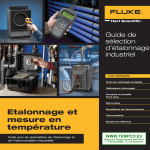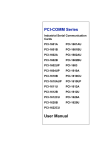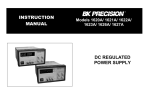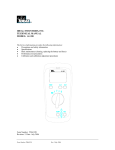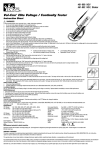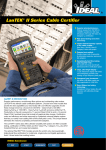Download IDEAL INDUSTRIES 61-095 User's Manual
Transcript
IDEAL INDUSTRIES, INC. TECHNICAL MANUAL MODEL: 61-095 The Service Information provides the following information: • Precautions and safety information • Specifications • Performance test procedure • Calibration and calibration adjustment procedure • Basic maintenance (cleaning, replacing the battery) Form number: TM61095 Revision: 2. Date: Sep 2002 Form number TM61095 Rev 2 September 2002 TABLE OF CONTENTS Page # 1 1 1 Title Introduction Precautions and Safety Information Symbols Safety 2 Specifications 3 General Specification 3 Voltage Specifications 4 Resistance and Continuity Specifications 4 Current Specifications 4 Physical and environment characteristics 5 Certification and compliance 5 Required Equipment 6 7 Basic Maintenance Opening the Meter Case 7 Replacing the Battery 7 Cleaning 7 8 Performance Tests Testing the Voltage Function 8 Testing the Resistance Function 9 Testing the Amp Function 9 10 Calibration 10 DCV, ACV, ACA Functions 11 Calibration Adjustment Points Form number TM61095 Rev 2 September 2002 Page 1 Introduction Warning To avoid shock or injury, do not perform the verification tests or calibration procedures described in this manual unless you are qualified to do so. The information provided in this document is for the use of qualified personnel only. Caution The 61-095 contains parts that can be damaged by static discharge. Follow the standard practices for handling static sensitive devices. For additional information about IDEAL INDUSTRIES, INC. and it’s products, and services, visit IDEAL INDUSTRIES, INC. web site at: www.idealindustries.com Precautions and Safety Information Use the meter only as described in the Users Manual. If you do not do so, the protection provided by the meter may be impaired. Read the “Safety Information” page before servicing this product. In this manual, a Warning identifies conditions and actions that pose hazard(s) to the user; a Caution identifies conditions and actions that may damage the meter or the test instruments. The Symbols The symbols used on the meter and in this manual are explained in Table A. Table A. The Symbols Symbol Meaning Symbol Alternating signal CAT III Meaning Battery Direct signal Earth ground IEC overvoltage Category III Double insulated Refer to the manual. Important information. Take appropriate precautions. Hazardous voltage may be present Form number TM61095 Rev 2 September 2002 Page 2 SAFETY Review the following safety precautions to avoid injury and prevent damage to this product or any products connected to it. To avoid potential hazards, use the product only as specified. CAUTION. These statements identify conditions or practices that could result in damage to the equipment or other property. WARNING. These statements identify conditions or practices that could result in personal injury or loss of life. Specific precautions Do not operate without covers. To avoid personal injury, do not apply any voltage or current to the product without the covers in place. Electric overload. Never apply a voltage to a connector on the product that is outside the range specified for that connector. Avoid electric shock. To avoid injury or loss of life, do not connect or disconnect probes or test leads while they are connected to a voltage source. Do not operate in wet/damp conditions. To avoid electric shock, do not operate this product in wet or damp conditions. Form number TM61095 Rev 2 September 2002 Page 3 SPECIFICATIONS All specifications are warranted unless noted typical and apply to the 61-095. Stated accuracies are at 23ºC ± 5ºC at less than 80% relative humidity and without the battery indicator displayed. General specifications Characteristics Description LCD display digits 3½ Display count 2,000 Numeric update rate 2.5 times / sec Polarity display Automatic Overrange display “OL” is displayed Low voltage indicator is indicated Automatic power-off time Automatic backlit off = 30 minutes Power source One 9V dry cell battery Maximum input voltage 600V CAT III between V and COM Maximum floating voltage 600V CAT III between any terminal and earth ground V connector V Temperature Coefficient 0.2 x (Spec. Accuracy) / ºC, < 18ºC or > 28ºC Battery Life 250 hours typical (alkaline) Form number TM61095 ,V , Ω, Rev 2 September 2002 Page 4 Measurement Characteristics Accuracy is ±(% reading + number of digits) at 23ºC ± 5ºC, less than 80% R.H. Voltage Function Range Accuracy Overload protection V 600 Vrms ± (1.5%+ 3 dgt) 40Hz ~ 500Hz 600 Vrms V 600 V ± (1% + 2 dgt) Input impedance: 1MΩ // less than 100pF. Resistance & Continuity Function Ω Range Accuracy Overload protection 2000 Ω ± (1% + 2 dgt) 600 Vrms Max. open circuit voltage: 3V Continuity check: Internal sounds activates if the resistance of the circuit under test is less than 25 Ω. It will then turn off if the resistance is increased beyond 400 Ω. AC Current Function A Range Accuracy Overload protection 200.0A ± (3% + 3 dgt)*45Hz ~ 66Hz 200A * Adjacent conductor influence: <0.05 A/A Form number TM61095 Rev 2 September 2002 Page 5 Physical and Environmental Characteristics Physical Characteristics Description Dimensions (H x W x D) 188mm x 66mm x 42mm Weight (with battery) 0.3Kg Environmental Characteristics Temperature operating Non-Operating Description 0 to + 50ºC -20 to + 60ºC Humidity (operating) < 80% R.H. Altitude Operating 2,000 m (6560 ft.) Non-Operating 12,300 m (40354 ft.) Vibration & shock Operating MIL-T-28800E (5 ~ 55Hz, 3g maximum) Conductor Size 12mm (0.5”) Indoor Use Indoor Use Certifications and Compliances Safety Designed to IEC 1010-1, UL3111-1 and CSA specifications Input rating IEC 1010 600V CAT. III Over voltage category CAT III: Distribution level mains, fixed installation. CAT II: Local level mains, appliances, portable equipment. CAT I: Signal level, special equipment or parts of equipment, telecommunication, electronics. Pollution Degree 2 EC Declaration of Conformity Form number TM61095 Do not operate in environments where conductive pollutants may be present. Meets the intent of Directive 89/336/EEC for Electromagnetic Compatibility and Low Voltage Directive 73/23/EEC for Product Safety. Compliance was demonstrated to the following specifications as listed in the official Journal of the European Communities: EN 55011 Class A: Radiated and Conducted Emissions. EN 50082-1 Immunity: IEC 801-2 Electrostatic Discharge IEC 801-3 RF Radiated EN 61010-1 Safety requirements for electrical equipment for measurement, control, and laboratory use. Rev 2 September 2002 Page 6 Required Equipment Required equipment is listed in Table B. If the recommended models are not available, equipment with equivalent specifications may be used. Repairs or servicing should be performed only by qualified personnel. Table B. Required Equipment Equipment Required Characteristics AC Voltage Range: 0-750V AC Accuracy: ±0.07% (Basic) Frequency Range: 40 ~ 500Hz Accuracy: ± 2% Calibrator DC Voltage Range: 0-1000V DC Accuracy: ±0.006% (Basic) Current Range: 0 ~ 100A Accuracy: AC (40Hz to 100Hz): ±0.08% (Basic) Resistance Range: 1Ω ~ 2000Ω Accuracy: ±0.03% (Basic) Form number TM61095 Rev 2 September 2002 Recommended Model Fluke 5500 or Wavetek 9100 Calibrator or Equivalent Ballantine 1620A Page 7 Basic Maintenance Warning To avoid shock, remove the test leads and any input signals before opening the case or replacing the battery or fuses. Opening the Meter Case Caution To avoid unintentional short circuit, always place the uncovered meter assembly on a protective surface. When the case of the meter is open, circuit connections are exposed. To open the meter case, refer to Figure 1 and do the following: 1. Disconnect test leads from any live source, turn the rotary switch to OFF, and remove the test leads from the front terminals. 2. Remove the battery door by using a screwdriver to turn the battery door screws turn counter-clockwise. 3. The case bottom is secured to the case top by three screws. Using a screwdriver, remove the three screws. Replacing the Battery The meter is powered by a single 9V battery. To replace the battery, refer to Figure 1. Figure 1 Cleaning Periodically wipe the case with a dry cloth and detergent. Do not use abrasives or solvents. Form number TM61095 Rev 2 September 2002 Page 8 Performance Tests The following performance tests verify the complete operability of the meter and check the accuracy of each meter function against the meter’s specifications. Accuracy specifications are valid for a period of one year after calibration, when measured at an operating temperature of 18ºC to 28ºC and at a maximum of 80% relative humidity. To perform the following tests, it is not necessary to open the case; no adjustments are necessary. Merely make the required connections, apply the designated inputs, and determine if the reading on the meter display falls within the acceptable range indicated. If the meter fails any of these tests, it needs calibration adjustment or repair. Testing the Voltage Function To verify accuracy in the AC voltage ranges, do the following: 1. Connect the calibrator to the VΩ and COM inputs on the meter. 2. Set the calibrator for the voltage and frequency from step 1 to 6 in Table 1. 3. Compare the reading on the meter display with the display reading shown in Table 1. 4. If the display reading falls outside of the range shown in Table 1, the meter does not meet specification. Table 1 AC Voltage Test: Step Input Frequency Reading 1 3V 50Hz 0 to 6 2 3V 500Hz 0 to 6 3 100V 50Hz 95 to 105 4 100V 500Hz 95 to 105 5 600V 50Hz 588 to 612 6 600V 500Hz 588 to 612 5. Turn the rotary switch to “V ” position. 6. Set the calibration for the voltage from step 1 to 3 in Table 2. 7. Compare the reading on the meter display with the display reading shown in Table 2. 8. If the display reading falls outside of the range shown in Table 2, the meter does not meet specification. Table 2 DC Voltage Test: Step Input Reading 1 3V 1 to 5 2 100V 97 to 103 3 600V 592 to 608 Form number TM61095 Rev 2 September 2002 Page 9 Testing the Resistance Function To verify the accuracy of the resistance function, do the following: 1. Connect the calibrator to VΩ and COM on the meter. 2. Turn the rotary switch to Ω. 3. Apply the inputs for step 1-4 in Table 3. 4. Compare the meter display readings to the display readings in Table 3. 5. If the display reading falls outside of the range shown in Table 3, the meter does not meet specification. Table 3 Resistance Test: Step Source Reading 1 100 Ω 97 to 103 2 180 Ω 176 to 184 3 1000 Ω 988 to 1012 4 1800 Ω 1780 to 1820 Max. Open Circuit Voltage: 3V Continuity check: Beeper sounds if the resistance of the circuit under test is less than 25 Ω. It will then turn off if the resistance is increased beyond 400 Ω. Amp (A) Function 1. Turn the rotary switch to A position. 2. Refer to Figure 1 and disconnect probes from probe test points. 3. Place the conductor anywhere within the sensor zone as shown in the shaded areas of Figure 2. 4. Apply the inputs for steps 1 - 4 in Table 4. 5. For each input, compare the reading on the meter display to the reading in Table 4. 6. If the display reading falls outside of the range shown in Table 4, the meter does not meet specification. Table 4 ACA Test: Step Source Frequency Reading 1 19.0A 50Hz 18.1 to 19.9 2 19.0A 500Hz 18.1 to 19.9 3 190.0A 50Hz 184.0 to 196.0 4 190.0A 500Hz 184.0 to 196.0 Form number TM61095 Rev 2 September 2002 Page 10 O K Figure 2 Top shows correct method; bottom shows incorrect method. Calibration Calibrate the meter once a year to ensure that it performs according to specifications. Perform calibration at an ambient temperature of 23ºC ± 2ºC and relative humidity of 75% or less. Calibration for the Model 61-095: 1. Disconnect the test leads from any circuit under test and turn off tester. 2. Loosen the screws from the battery cover, remove battery cover and pull the battery out of battery box with battery still connected. 3. Loosen the three screws from the bottom case. 4. Lift the bottom case. (A) DCV Calibration (Adjust VR1; See Figure 3) 5. Set the test to DCV function. 6. Set the output of calibrator for DCV 600V and connect to V and COM test probes. 7. Using a small flat-tipped screwdriver adjust the potentiometer VR1 until the display reads 600. 8. Disconnect the output terminals of DCV calibrator. (B) ACV Calibration (Adjust VR2; See Figure 3) 9. Set the tester to ACV function. 10. Set the output of ACV calibration for 300V 50Hz and connect to V and COM test probes. 11. Using a small flat-tipped screwdriver adjust the potentiometer VR2 until the display reads 300. 12. Disconnect the output terminals of ACV calibrator. (C) ACA Calibration (Adjust VR3; See Figure 3) 13. Set the tester to ACA function. 14. Flow the current of ACA 100.0A 50Hz around the suitable wire or conductor. 15. Place conductor anywhere within the sensor zone. 16. Using a small flat-tip screwdriver adjust the potentiometer VR3 until display reads 100.0 to 100.1. Remove the tester away from the wire or conductor. Form number TM61095 Rev 2 September 2002 Page 11 Figure 3 - Calibration Adjustment Points Form number TM61095 Rev 2 September 2002













